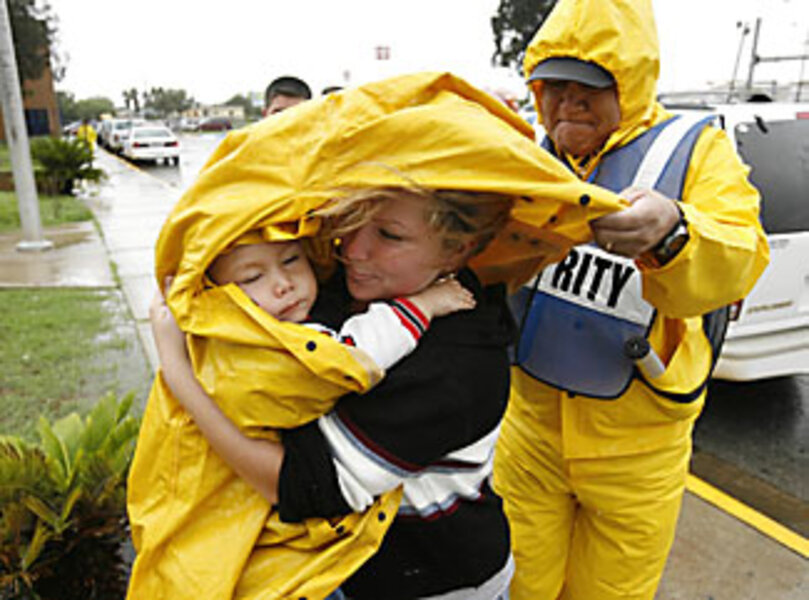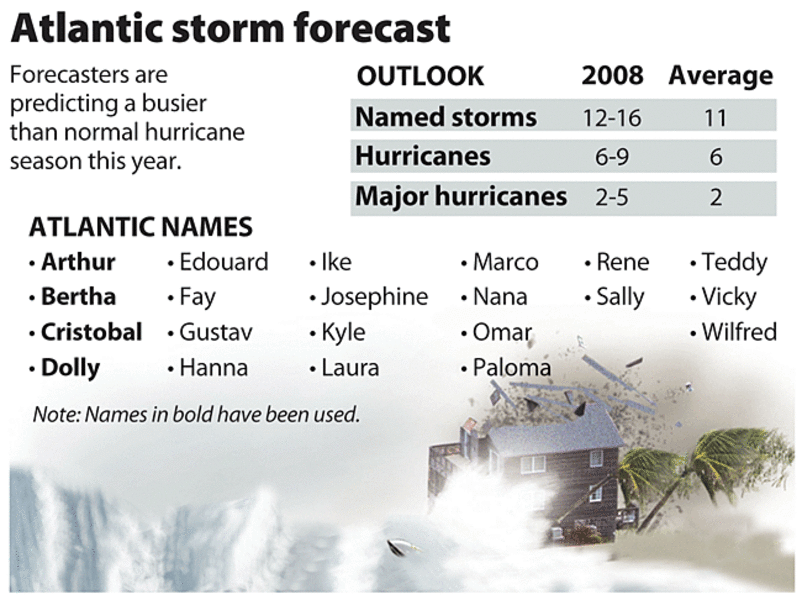Hurricane season: big start
As the remnant of hurricane Dolly creeps toward far northern Mexico, the 2008 Atlantic hurricane season already is generating buzz as hurricane specialists look at July's unusually high level of activity.
The three named storms so far this month appear to bolster forecasts for a very active season this year. They also appear to fit what some researchers see as an emerging pattern of storms that form earlier as well as later than usual, in effect lengthening the active period within the hurricane season. The official season runs from June 1 to Nov. 30.
Whether or not that pattern holds up to scrutiny, there is little question that this year's Atlantic hurricane season is off to an energetic start.
"The atmosphere's just juicier than it normally is in June and July," says Phil Klotzbach, a research scientist at Colorado State University. He notes that ocean temperatures in a key region of the eastern Atlantic Ocean have been warmer than normal and air pressures at sea level there have been lower than normal – conditions that favor storm formation and growth. Moreover, the lack of El Niño conditions in the tropical Pacific appears to be reducing the sharp differences in wind speed with height over the Atlantic that tend to stifle tropical-cyclone formation.
With the 2008 season just shy of two months old, July's storms either broke records or bumped the month into the top tier among Julys past.
Hurricane Bertha entered the record books as the longest-lived July storm on record. And it formed farther east in the Atlantic – just south of the Cape Verde islands – than any June or July storm since at least 1950. The storm's longevity helped push the month into fourth place – behind July 2005, 1933, and 1916 – based on a measure of storm strength and lifetime, dubbed the ACE index.
Typically, activity in June and July doesn't say much about the rest of the season, says Dr. Klotzbach, unless that activity is triggered in the deep tropics, where Bertha was born. Bertha's 17.25-day life span "was pretty phenomenal," he says. And researchers note that in each of the other three years in which ACE values for the month were high, the hurricane seasons went on to post at least five major hurricanes – those reaching Category 3 or higher in a five-category rating system.
This month's activity would appear to lend credence to the notion that over the past century, the length of the storm season – measured by when the first storm appears and the last one fades – has been slowly growing. Informal calculations by Jay Gulledge, an ecologist and senior scientist with the Pew Center on Global Climate Change, show such a trend. Dr. Gulledge looked at federal hurricane statistics dating back to 1855. But instead of using the June 1 to Nov. 30 time frame for a season, he used March 1 to Feb. 28, which coincides more closely with the ocean's warming and cooling with the change of seasons. Since 1915, he says, it looks as if the length of the hurricane season as he's defined it has expanded by an average of five days per decade.
He cautions that so far, he has not published the results in a peer-reviewed journal – although he did present the work as part of a panel at a geophysical meeting in 2006. Still, he says, "I think the effect is real."
For his part, Klotzbach ran his own numbers after hearing about Dr. Gulledge's informal study. Klotzbach says he's found no statistically significant trend in season length.
Others, such as Georgia Tech's Judith Curry, note that Gulledge's results pull in a number of weak storms whose presence on the list could be an artifact of improvements in observing hurricanes from the air and from space. Still, she says, some researchers say they are finding evidence that Gulf of Mexico storms are forming earlier and Atlantic storms are forming later than normal.
The jury is still out on whether a global-warming connection exists or whether any changes in the Atlantic hurricane season are driven by natural shifts in climate over storm-forming regions.
But "The main signal from global warming remains the increased percentage of Category 4 and 5 storms, which is a global signal," she adds.







